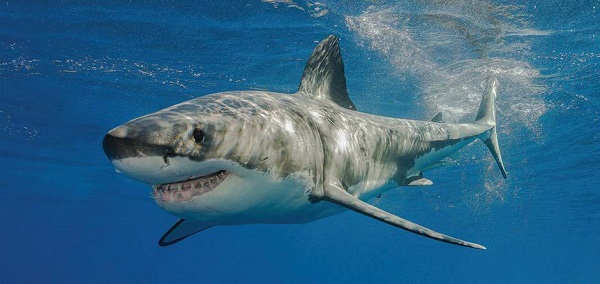Sharks and friction
R. David Whitby | TLT Worldwide March 2020
Using basic principles of tribology, sharks rank among nature’s fastest swimmers.

Slower-swimming sharks have asymmetrical tails with a top lobe nearly half their length.
As most swimmers will tell you, it is much easier to walk than it is to swim. This is because of the density of water compared to air. But why is it that sharks are able to swim so fast? Sharks need to be able to swim very fast in order to catch their fish prey.
The shape of a shark’s body is one reason for their ability to swim fast. Most sharks, like dolphins, tuna, swordfish and porpoises, have streamlined, torpedo-shaped bodies that allow them to swim through the water with a low amount of friction. Most bottom-dwelling sharks have flattened bodies that let them hide in the sand on the ocean bed. These slower-swimming sharks usually hide on the ocean floor and burst out of the sand to surprise their prey.
Streamlining allows a shark to swim with less physical exertion. Since an animal never really knows what its energy reserves are and when they are going to be needed, it is always wise to prepare for a possible scarcity by using energy efficiently. Fast-swimming predators (such as great white, Mako, tiger and hammerhead sharks) have tails with lobes that are almost the same size. Slower swimming sharks have tails that are more asymmetrical. Thresher sharks have tails where the top lobe is up to half their body length.
Swimming style and body form are intimately linked. Lamnid sharks (great white, Mako, tiger and similar sharks) combine a solidly built, torpedo-shaped body, a narrow tail stalk supported by lateral keels and a crescent moon-shaped caudal fin. Unlike the graceful, nearly whole-bodied swimming stroke used by a typical whaler shark, the lamnids swim in a relatively stiff-bodied fashion. Each swim stroke involves arching the body laterally into a shallow curve, with the amplitude increasing from very small, at the head and anterior two-thirds of the body, to large at the posterior edge of the caudal fin. By oscillating the body from side-to-side in this fashion, tremendous swimming speeds can be achieved with remarkable energy economy. Rapid movement of the tail enables these sharks to accelerate very quickly.
The other factor that allows sharks to swim faster than their prey is the surface of their skin. Shark skin is made of a matrix of tiny, hard, tooth-like structures called dermal denticles or placoid scales. These structures are shaped like curved, grooved teeth and make the skin a very tough armor with a texture like sandpaper. They have the same structure as a tooth with an outer layer of enamel, dentine and a central pulp cavity. Unlike the scales of bony fish (ctenoid scales) that get larger as the fish grows, placoid scales stay the same size. As the shark grows, it just grows more placoid scales.
All the spines of the placoid scales point backward (towards the tail), so it feels relatively smooth when you move your hand from head to tail but rough the other way. The scales are arranged in a mosaic pattern which surrounds the body of the shark like a helix and acts as a supportive corset. Because sharks have no skeletal bones, the muscles used for swimming are attached directly to the inside of this corset. This saves energy, allowing them to swim faster and further without tiring.
The scales also help the shark swim more quickly because their streamlined shapes help to decrease the friction of the water flowing along the shark’s body by channelling it through grooves. They also aid in streamlining the shark while it glides through the water, as they reduce turbulence. This is done by directing the water through the grooves and thereby decreasingthe friction of the water against which the body travels.
The skin of the shark has to be thick in order to assist it in retaining heat and supporting the muscles attached to its inner layers. The largest living shark, the whale shark, has skin that is about 10 centimetres (four inches) thick.
In general, sharks swim (or cruise) at an average speed of about eight kilometers per hour (five mph), but when feeding or attacking the average shark can reach speeds upward of 19 kilometers per hour (12 mph). Shortfin Mako sharks, the fastest shark and one of the fastest fish, can burst at speeds up to 50 kilometers per hour (31 mph).
David Whitby is chief executive of Pathmaster Marketing Ltd. in Surrey, England. You can reach him at pathmaster.marketing@yahoo.co.uk.